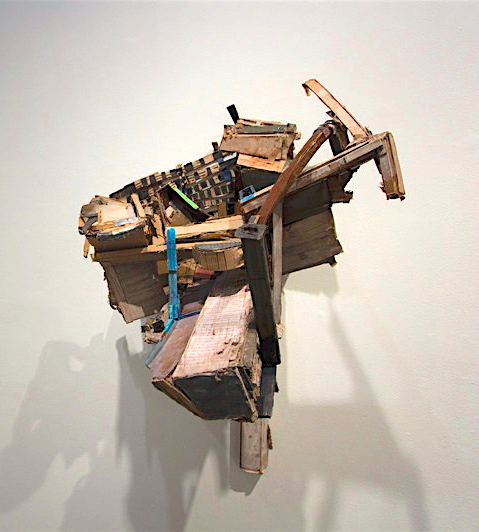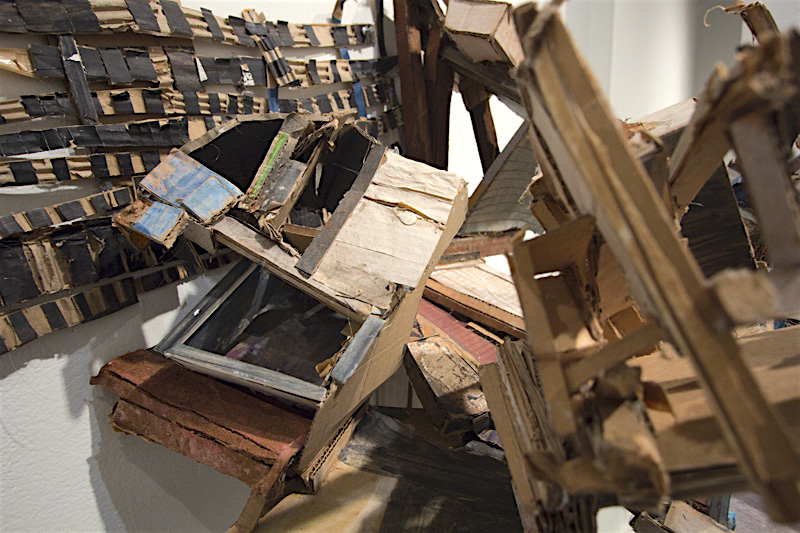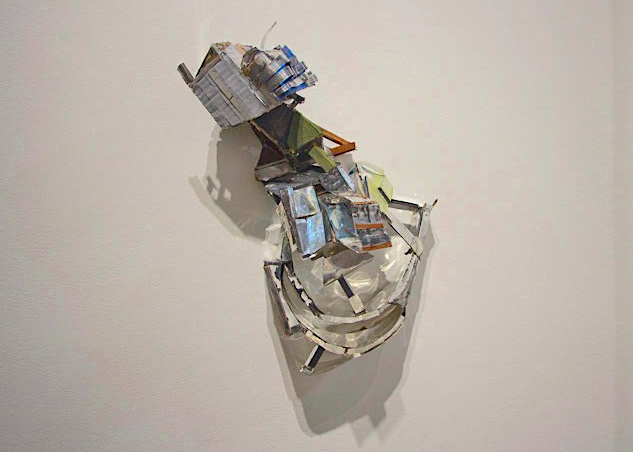Pareidolia for Relational Survival: Sculptures by Michelle Marcuse
Pareidolia for Relational Survival
SCULPTURES BY MICHELLE MARCUSE
This essay by Laurel McLaughlin is the fourth in a series of essays archiving one year of Grizzly Grizzly exhibitions, in celebration of our 10th year as an artist collective. Throughout the year, we will be collaborating with exhibiting artists and emerging and established writers to produce essays that critically reflect on the exhibitions and expand the ideas explored in our experimental project space. In addition to being posted on this blog, the collected essays will culminate in our first bound publication, to be released in September 2019. Support for this year-long project, that fosters writing in the visual arts, was generously provided by The Velocity Fund administered by Temple Contemporary with generous funding from The Andy Warhol Foundation for the Visual Arts.
Michelle Marcuse’s new works in her exhibition at Grizzly Grizzly activate liminal spaces that emerge between material precarity and seemingly impossible structural relationships. In her six wall-mounted sculptures, apparent smoothness gives way to ragged adjacent edges; negative space seems to buttress the weight of teetering towers and hidden tunnels; and together in the gallery, they modulate between a collective architectural schematic and individual industrial “islands.”[1] What are these forms that evoke such empathy and urgency, shifting between ruins and futuristic communes? Are they pieces of Pangea, broken off and clarified? Are they tectonic compasses of a future perfect tense, only making sense when adjoined? Or, are they possible frames, each leaning-to an understanding of a messy and emergent present?
Michelle Marcuse, Installation View
To work towards an understanding of the sculptures is to acknowledge their dualities, and perhaps none is more apparent than that of foreboding and play. This dialectic emerges from the materiality of the works, as Marcuse revealed that they are “repurposed,” composed from older works, finding temporary shelter in their current states. Others are new but made from recycled materials.[2] In various forms of salvage, they are all “interventions on the wall,” alluding to previous spaces and inhabiting their new context.[3] Previous works such as No Logic in Line shown at Philadelphia’s Fleisher Art Memorial used clearly-defined cardboard shapes in dense arrangements, evoking feelings of loss, mourning, and displacement. Reviews associated such works with the shantytown cityscapes of Capetown in her native South Africa; but here, Marcuse recasts that compressed feeling of pastness anew in constructions teeming with space. Fibrously textured and makeshift in composition, the works move away from the memorial towards various states of becoming—what children might imagine in games. In Own Sphere of Memory, 2019 a circular vortex of links, associated with both fences and ladders, wraps itself around a central and abstracted landscape. The sculpture projects from the wall, a black circle of perforated links teeter on the brink of falling into our spaces, while simultaneously beckoning us towards it. Positioned lower than the other works in the gallery, we approach it with reverence, as if approaching a shrine, daring to peer into its chasm-like center. Reaching the interior, however, we find playful ridges, grafts, planes, and contours within, held together by gossamer strands of hot glue. It is provisional, like a paper castle, and also brooding, as if hiding something darker.
Own Sphere of Memory, mixed media, paint, cardboard, 2019
Another elision—that of the apparent past and simultaneous formation of the present. It is a pairing that Marcuse welcomes in her process as traumatic memories and what she understands as resilient fantasies take shape within the sculptures.[4] But rather than future-facing, this combination incites a sense of urgency contingent on a present tense. For instance, Holding Absent projects curved slivers of cardboard from a central column, embodying an impossible action—holding absence—while its title insists that it completes the action. It is as if the cardboard strains to contain its own negative space, while the space continues to expand. This oppositional effort unfolds before our eyes, imparting a continuous push and pull that inhabits not only the works, but the corners of our social spaces as well
Holding Absence, mixed media, paint, 2019
The push and pull in the present ultimately emanates from Marcuse’s keen awareness of her communities in all locations. Observations permeate her process of making in the studio, flashing up in moments of dense concentration, and at other times requiring rhythms of speedy composition, as with this series. She describes this intuitive process as thinking by doing. The observations that wend their way most strongly into her studio are emotional connections with discarded materials, joints that do not quite match up, and spaces that are vulnerable. Marcuse describes an inkling of “spirituality” in finding a sense of beauty in something like the crinkled tin of a used soda can on the street.[5] A sense of human precarity perhaps is contained within. But this mysterious sense of connection does not emerge from a vertical power structure, or a deliberate elevation of low materials to the place of “high art.” Marcuse instead articulates a horizontal recognition of potential in the quotidian, leaving room for multiple outcomes. She feels, what we might call, a kinship with such materials. And in this horizontal potentiality, Marcuse strives to see all sides—literally and conceptually. Often times in the process of sculpting, she employs a mirror, looking at the object right in front of her from another angle in the same time and space. She thus situates her works in multiple positions of the discarded objects she sees in the everyday, choosing to revel and engage with their present states.
The temporality and potential of Marcuse’s sculptures shares affinities with Thomas Hirshhorn’s monuments, not in the sense of his grandiose stagings, but in the installations’ attempt to meet materials, and consequently viewers, where they are.[6] In Bataille Monument, 2002, from Documenta 11, Hirshhorn employed cardboard, duct tape, plastic wrap, and detritus from Kassel to erect temporary architectures that are complicit with and simultaneously critique cultural obsessions with consumerism and capital. Hirshhorn’s Bataille Monument was composed of nine structures, including a library, exhibition, public sculpture, and café, both producing a microcosmic cultural center, while simultaneously welcoming viewers—no matter their education or means—to partake in “building” the structures through participation. Characterizing the Bataille Monument and three other Hirshhorn installations dedicated to philosophers as “anti-monuments,” curator and scholar Simon Sheikh contends that such works counter nostalgia and transcendence, in favor of an “immanence” rooted in the now.[7] Sheikh’s conception of presentness notably owes its foundation to philosopher Gilles Deleuze and his interpretation of philosopher Baruch Spinoza’s (1632–1677) formulation of immanence.[8] In Sheikh’s essay, these thinkers are strung together across time, referencing various publics and still articulating a broader and perhaps more global presence of immanence.[9] So, what is the connection between the specificities and broader articulations of immanence in Marcuse’s sculptural works?
One could say that Marcuse references the local and global, of both Capetown and Philadelphia, in addition to potential structures for urban environments around the world. Unlike Hirshhorn, however, she does not cite them directly. There is no particular mandate in Reservoir of Lost or History and Unreason, both 2019, to consider Philadelphia’s increasing gentrification or South African landscapes plagued by histories of apartheid; but rather, a vague urgency underlies each joint, link, and bind in these sculptures, illuminating the precarity in each moment, in all places. Reservoir of Lost divulges the feeling of such an encounter. Its title conveys a confluence of water with that which is lost for a structure that appears like an impossible architecture. In looking, perhaps we wonder whether its muted blue streaks calm us into forgetting the lost, or does its imbalance prompt our reconsideration? Can the “reservoir” contain all of that which is “lost” in a world brimming with the effects of global warming? Will there be anything outside of the reservoir which is not lost for generations to come, or will there be only disparity? Marcuse’s sculptures guide us on the fringes of such thinking, emanating from one’s local experiences and expanding into broader global arenas.
History and Unreason continues such a nuanced guiding. The work is the sole sculpture to use mirrored mylar—a new material for Marcuse. Recalling her process employing mirrors, the material represents a curious convergence of past banalities reflected and reformed within the new. And yet, it does not conceal the imbalances in such a process. Much like Hirshhorn’s off-kilter environments, History and Unreason veers to one side, with its top segment, that Marcuse described as never quite fitting in other works, counterbalancing the lower portion. A multilayered sweep of mirrored strips in the lower portion reflect our faces back to us, implicating us in its structure. Alongside our faces, other mirrored strips reflect one another, positioning infinity nearby. Marcuse’s structures do not present binaries, but instead conjoin us within an adjacent immanence that calls us to care. History and Unreason thus embodies and projects a seeming confluence of paradoxes: the societal plagues that have and continue to burden us despite our knowledge of them—such as imbalances of power and displacement—alongside a counterintuitive cultural structure of immanence, that makes us see the present differently.
In the end (that actually resists finitude), the sculptures continue to shift and shape in the present, and one might say that these “islands” and their visions of the potential present are a kind of last plea for structural reconsiderations. We might think of them in this light as pareidolia for relational survival.
History and Unreason, mixed media, paint, 2019
[1] Laurel McLaughlin and Michelle Marcuse, Conversation with the artist, January 25, 2019.
[2] Ibid.
[3] Laurel McLaughlin and Michelle Marcuse, Conversation with the artist, February 11, 2019.
[4] Michelle Marcuse, “Artist’s Statement,” InLiquid Website, Accessed January 23, 2019: https://inliquid.org/artist/marcuse-michelle/.
[5] Laurel McLaughlin and Michelle Marcuse, Conversation with the artist, February 11, 2019.
[6] Ibid.
[7] AM Weaver, “Carrying the Dreamer,” Michelle Marcuse Website, Accessed January 26, 2019: https://www.michellemarcuse.com/essay.
[8] Simon Sheikh, “Planes of Immanence, or The form of ideas: Notes on the (anti-) monuments of Thomas Hirshhorn,” Afterall: A Journal of Art, Context and Enquiry, Issue 9 (Spring/Summer 2004): 90–98, 92.
[9] See Gilles Deleuze, Pure Immanence: Essays on a Life, Anne Boyman, trans. (New York, NY: Zone Books, 2001).
Laurel McLaughlin is a PhD candidate in the History of Art at Bryn Mawr College and the Brunilde Sismondo Ridgway Curatorial Fellow at the Institute of Contemporary Art, Philadelphia. Her dissertation research traces migratory identity formation in feminist performance situated in the United States and its strategies of dispersal in various forms of documentation from the 1970s to the 21st century. She has presented her research at the University of Pittsburgh, the University of Pennsylvania, the University of California, Berkeley, and the College Art Association, New York, among others. Additionally, she has held research and curatorial assistant positions at the Philadelphia Museum of Art, Slought Foundation, and the Pennsylvania Academy of the Fine Arts.
Michelle Marcuse lives and works in Philadelphia, PA. She is Co-Director of HOUSEGallery, a mixed-use exhibition space in Fishtown, Philadelphia. She received a Bachelor of Design at Shenkar College, Israel [1982], continued to Michaelis School of Art at the University of Cape Town [1983], and completed her BFA at Tyler School of Art in Philadelphia [1985]. She was invited to exhibit with BLAM Projects Brooklyn, NY [2016], Arte y Amor at Taller Boricua, NYC [2016], and Borderless Caribbean at The Haitian Cultural Arts Alliance, Miami, FL [2015]. Michelle is a recipient of a 2016 Fleisher Art Memorial Wind Challenge exhibition and was awarded a full fellowship to The Vermont Studio Center [2012]. Marcuse’s work has been acquired by the US Embassy in Bangkok, Thailand, the University of Notre Dame in Baltimore, MD, and the State Museum of Pennsylvania in Harrisburg, PA. Her work is part of the Philadelphia Museum of Art collection in Philadelphia, PA. Her work was presented for a six-month period in 2017/2018 at the Science and History Institute in Philadelphia, PA. Most recently, she became a Finalist with CFEVA’s Visual Artist Fellowship. In December 2018 her work was included in Against Gravity: TECTONICS - Imagined Spaces: an exhibition organized by DORCAM in collaboration with The Collection Suites in Miami, FL.







